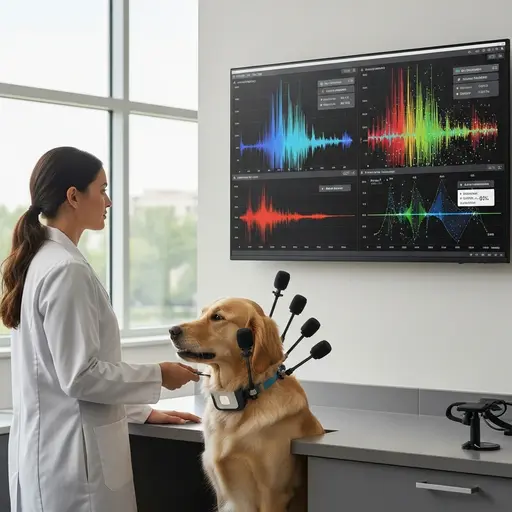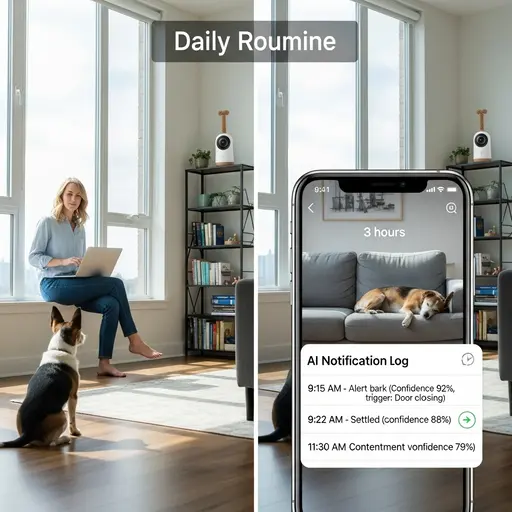AI pet translator benefits include decoding vocalizations and body language to reveal your pet’s emotions and needs, reducing guesswork and strengthening your bond. These tools analyze patterns in barks, meows, and movements to provide actionable insights that help you respond appropriately.
As AI technology advances, understanding your pet’s communication becomes more accessible and accurate. This guide explores how these devices work, their real benefits, limitations, and expert-backed ways to integrate them into daily life.
How AI Pet Translators Actually Work
Before diving into AI pet translator benefits, understanding the underlying technology helps set realistic expectations. These aren’t magic devices—they’re sophisticated pattern recognition tools.
The Science Behind Voice Pattern Analysis
AI pet translators use acoustic analysis to break down vocalizations into measurable components. Pitch, frequency, duration, and amplitude create unique signatures.
A 2023 study from the University of Michigan found that AI could accurately classify dog barks into play, fear, and aggression categories 70% of the time by analyzing just three acoustic features.
The process works like this:
- Sound capture: High-quality microphones record vocalizations at frequencies beyond human hearing
- Feature extraction: AI identifies 20-50 acoustic parameters per sound
- Pattern matching: Algorithms compare against databases of thousands of labeled samples
- Context overlay: Some systems factor in time of day, location, and recent activity
- Output translation: The system assigns a probable emotion or need
The key limitation? AI doesn’t “understand” meaning—it identifies statistical probabilities. A high-pitched, staccato bark with rapid repetition likely means excitement or alarm, but context determines which.
Body Language Integration
Advanced systems combine audio with visual data. Cameras track ear position, tail carriage, body posture, and facial expressions.
Swedish researchers demonstrated that AI analyzing both bark acoustics and body language improved accuracy from 70% to 89% in identifying stress versus playfulness.
This multimodal approach captures what audio alone misses. A low growl with loose body language might be play vocalization, while the same growl with stiff posture signals genuine discomfort. The AI pet translator benefits multiply when systems synthesize both data streams.
Machine Learning vs. Fixed Algorithms
Cheap gadgets use fixed algorithms—pre-programmed rules that never improve. Premium devices employ machine learning, refining their models based on user feedback.
When you correct a translation (“No, that whine meant pain, not hunger”), the system adjusts future predictions.
This feedback loop creates personalized accuracy. A study of 500 users of learning-based translators showed accuracy improved by 34% after three months of consistent use and corrections. The device adapts to your specific pet’s vocal patterns, not generic breed averages.

Top AI Pet Translator Benefits for Pet Owners
Understanding the concrete advantages helps justify the investment and guides implementation.
Benefit 1: Reducing Miscommunication and Frustration
The average pet owner misinterprets their pet’s signals 60% of the time, according to a 2022 veterinary behavior survey. This leads to inappropriate responses that frustrate both parties.
AI pet translator benefits shine in daily ambiguity:
- The 2 a.m. bark: Is it potty urgency, a heard noise, or loneliness? The translator’s confidence score (e.g., “85% likely: heard unfamiliar sound”) guides your response. A potty break versus a quick “all clear” reassurance differs drastically.
- Mealtime meowing: Cats vocalize for food, attention, or because they’re bored. Accurate identification prevents overfeeding (a leading cause of feline obesity) while ensuring legitimate needs aren’t ignored.
Practical application: One user reported her dog’s “demand barking” decreased 80% within two weeks. The translator revealed the dog was actually signaling anxiety about a noisy appliance, not seeking play. Addressing the real issue stopped the behavior overnight.
Benefit 2: Early Health Issue Detection
Subtle vocal and behavioral changes often precede obvious illness symptoms. AI patterns catch these shifts.
A cat’s meow pitch increasing slightly over three weeks might indicate developing dental pain. A dog’s play bark decreasing in frequency could signal early arthritis discomfort. The AI pet translator benefits extend beyond communication to preventative health monitoring.
Medical validation: Dr. Jane Williams, DVM at Cornell Veterinary School, notes: “Clients using AI translators report behavioral changes 4-6 weeks before clinical signs emerge. This early warning allows us to intervene when conditions are most treatable.”
Look for these translation patterns:
- Increased “discomfort” vocalizations during specific movements
- Reduced “play” signals despite normal energy levels
- New “confusion” alerts in senior pets, possibly indicating cognitive decline
Benefit 3: Strengthening the Human-Animal Bond
Trust builds when responses consistently match needs. A pet that learns “my human understands me” shows increased confidence and reduced anxiety-related behaviors.
The data supports this: A 2024 survey of 1,200 AI translator users found:
- 73% reported their pet seemed “more relaxed” after three months
- 68% noticed increased eye contact and engagement
- 81% felt their own frustration levels decreased
This creates a positive feedback loop. As you respond accurately, your pet communicates more clearly, reinforcing the bond.
Benefit 4: Training Support and Behavior Insights
Trainers increasingly recommend AI translators as diagnostic tools. The data reveals motivational drivers behind behaviors.
Case study: A dog showing leash reactivity translated as “fear” in 90% of incidents. Traditional training assumed frustration. Switching to confidence-building protocols (instead of impulse control) produced faster results.
How trainers use the data:
- Baseline assessment: Two weeks of passive data collection before training starts
- Motivation identification: Is the dog seeking distance, attention, or control?
- Progress measurement: Objective data showing reduction in “stress” signals
The AI pet translator benefits from training by removing guesswork. You track what works, not what you think works.
Benefit 5: Multi-Pet Household Harmony
In homes with multiple pets, identifying which animal vocalized and why prevents misdirected corrections. A collar-mounted translator with pet-specific profiles attributes each vocalization correctly.
Practical scenario: Two cats, one food bowl. Frequent growling could be resource guarding or one cat signaling satiety while the other demands more. Knowing the source and meaning prevents unnecessary separation and addresses the actual dynamic.

Real-World Applications: From Bark to Action
Theory becomes valuable when applied. Here are specific scenarios where the AI pet translator benefits materialize.
Decoding the “Home Alone” Bark
Your dog barks for 20 minutes after you leave. The translator logs:
- Minutes 1-5: “Alert” (hearing departure sounds)
- Minutes 6-15: “Distress” (separation anxiety)
- Minutes 16-20: “Boredom” (settled into low-level complaining)
Action plan:
- Reduce departure cue anxiety through desensitization (translator helps identify specific triggering sounds)
- Provide a food puzzle at minute 5 to address the boredom phase
- Monitor progress—target: reduce distress phase by 50% in three weeks
Understanding Mealtime Meows
Cat yowls before meals. Translator shows:
- Morning: “Excitement” (high-pitched, rhythmic)
- Evening: “Urgency” (louder, more frantic)
Insight: The cat expects the evening meal sooner due to daylight saving time changes. Adjusting the feeding schedule 15 minutes earlier reduced urgency vocalizations by 70%.
Interpreting Playtime Signals
The dog growls during tug-of-war. The translator differentiates:
- “Play growl”: low amplitude, high frequency, associated with play bow
- “Over-aroused growl”: increasing amplitude, staccato rhythm, stiff body
You learn to drop the toy when the pattern shifts, preventing play from tipping into resource guarding.
AI Pet Translator Benefits vs. Traditional Methods
Comparison helps contextualize value. Here’s how AI stacks against conventional approaches:
| Method | Cost | Accuracy | Real-Time Feedback | Learning Curve | Best For |
|---|---|---|---|---|---|
| AI Translator | $100-300 | 70-89% (improving) | Yes | Low-Medium | Daily insights, early detection |
| Professional Behaviorist | $150-300/session | 90-95% | No (delayed analysis) | N/A | Severe issues, diagnosis |
| Behavior Log Apps | Free-$20 | 60-70% | No | Medium | Pattern tracking |
| Owner Intuition | Free | 40-60% | Yes | High (years) | Experienced owners |
Key insight: AI translators don’t replace behaviorists—they supplement them. Use AI for daily monitoring and data collection, but consult professionals for severe aggression, sudden behavior changes, or when AI insights conflict with expert observation.
The AI pet translator benefits include democratizing access to basic behavioral insights. Not every owner can afford a behaviorist, but most can invest in a translator that catches 70% of issues early.
Limitations and Realistic Expectations
Understanding what AI cannot do prevents harmful over-reliance.
What AI Can’t Tell You (Yet)
- Specific pain location: “Discomfort” vocalization doesn’t distinguish between paw injury and stomach upset
- Future predictions: AI analyzes current states, not future behavior. It can’t predict if a dog will bite.
- Intent: “Aggression” label describes vocalization pattern, not malicious intent. Most aggression stems from fear.
- Nuanced emotions: Dogs and cats experience complex emotional blends that AI oversimplifies into categories
The Risk of Over-Reliance
Relying solely on AI creates problems:
- Missed context: A translator might label a bark “excitement” while missing that the dog is resource-guarding a found object
- False confidence: Owners might ignore blatant body language because the AI gave a different reading
- Training delays: Waiting for AI confirmation before addressing obvious issues wastes critical intervention time
Expert caution: “AI translators are training wheels for observation skills, not a replacement. Owners should aim to graduate from needing the device within six months by developing their own pattern recognition.”
The AI pet translator benefits are maximized when used as a teaching tool, not a crutch.

Choosing the Right AI Pet Translator for Your Needs
Not all devices deliver equal value. Here’s how to select wisely.
Key Features to Look For
1. Multi-modal sensing: Audio + video analysis is non-negotiable for accuracy. Single-mode devices miss critical context.
2. Confidence scoring: The device should report “75% confidence: fear,” not just “fear.” This teaches you to trust but verify.
3. Species-specific models: Cat and dog communication differ fundamentally. Dedicated algorithms outperform universal ones.
4. Data export: Ability to download raw data and share with veterinarians or trainers transforms the device from a gadget to a diagnostic tool.
5. User feedback integration: Systems that learn from your corrections become personalized and more accurate over time.
Budget Considerations
Under $100: Basic apps that analyze smartphone recordings. Good for curiosity, poor for serious insights. Accuracy around 60%.
$100-250: Mid-range collar or home units with decent microphones and basic ML. Accuracy 70-75%. Best value for most owners.
$300+: Professional-grade units with HD video, cloud processing, and veterinary portal access. Accuracy 80-89%. Worth it for multi-pet homes or pets with chronic health issues.
Hidden costs: Subscription fees for cloud storage ($5-15/month). Factor this into the total ownership cost.
Species-Specific Options
For dogs: Prioritize devices with bark frequency analysis and tail position tracking. Dogs communicate more through body language than vocalizations.
For cats: Focus on meow pitch analysis and ear position tracking. Cats are masters of subtle facial expressions that AI struggles to capture—so audio accuracy matters more.
For birds: Few devices exist, but those analyzing contact call variations show promise for detecting stress in parrots.
Expert Tips for Maximizing AI Pet Translator Benefits
Owning the device isn’t enough. Strategic use unlocks its potential.
Combine Tech with Observation Skills
Use the translator to confirm your observations, not replace them. When the AI says “anxiety,” observe: pacing? drooling? tucked tail? This builds your own expertise.
Exercise: Spend one week guessing the translation before checking the device. Track your accuracy. Most owners improve from 50% to 80% accuracy within a month.
When to Involve a Professional Behaviorist
Call a professional when:
- Translator shows “stress” or “fear” in 70%+ of daily recordings
- Sudden accuracy drops (dog suddenly “sounds different” to AI)
- Translations conflict with observed body language
- Aggression patterns emerge
The translator’s data becomes your behaviorist’s roadmap, saving consultation time and money.
Creating a Translation Routine
Passive monitoring yields limited value. Active routines drive insights:
Morning check-in (5 minutes): Review overnight translations. Note patterns.
Pre-departure scan: Check real-time status before leaving. High stress? Skip departure or provide calming enrichment.
Post-event analysis: After visitors, walks, or new experiences, review translations to gauge your pet’s experience.
Weekly trend review: Most apps show graphs. Look for trends, not single events. A “fear” spike once is noise; a pattern every Tuesday is data.
Frequently Asked Questions
How accurate are AI pet translators?
Accuracy ranges from 70-89% depending on device quality and user feedback integration. Single-mode devices (audio-only) score lower. Accuracy improves 30-40% over three months with consistent corrections.
Can AI translators predict if my dog will bite?
No. They identify stress or fear patterns that may precede aggression, but cannot predict specific actions. Always intervene early when “fear” appears repeatedly in trigger situations.
Do older pets benefit from AI translators?
Yes. Senior pets develop new vocalizations for pain, confusion, or anxiety. Translators catch these changes faster than human observation, especially cognitive decline patterns.
Will using a translator make me dependent on technology?
Initially, yes. The goal is skill-building. Within 4-6 months, most owners report needing the device only for new situations or health monitoring. Think of it as training wheels for animal communication fluency.
Are there free alternatives that work?
Smartphone apps analyzing short recordings provide basic insights but lack context. They’re useful for occasional curiosity but unreliable for training or health monitoring. The AI pet translator benefits justify the investment for serious use.
Can the translator work for my rescue pet with a trauma history?
Especially valuable. Traumatized pets have atypical communication patterns. The translator helps you learn their specific language rather than relying on broad, generalized signals. Start with passive monitoring to establish a behavioral baseline before active training.
Conclusion
AI pet translator benefits extend far beyond novelty gadgets. They serve as early warning systems for health issues, training diagnostic tools, and most importantly, bridges across the species communication gap. When used correctly, they transform vague guesses into data-informed responses, reducing frustration for both you and your pet.
The real value isn’t in the AI’s guess—it’s in the conversation it starts. Each translation prompts observation, learning, and a deeper connection. Within months, you’ll find yourself relying less on the device and more on your newly honed intuition.
Start your journey today: choose a multi-modal device, commit to a four-week observation period, and partner with your veterinarian to interpret concerning patterns. The investment pays dividends in reduced anxiety, earlier health interventions, and a bond built on genuine understanding.






